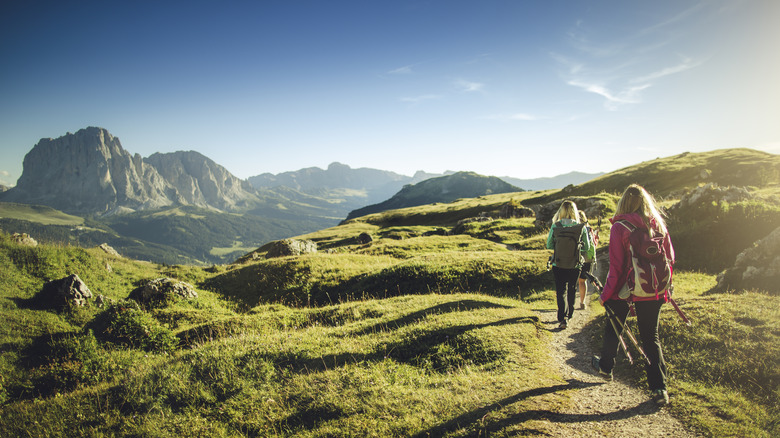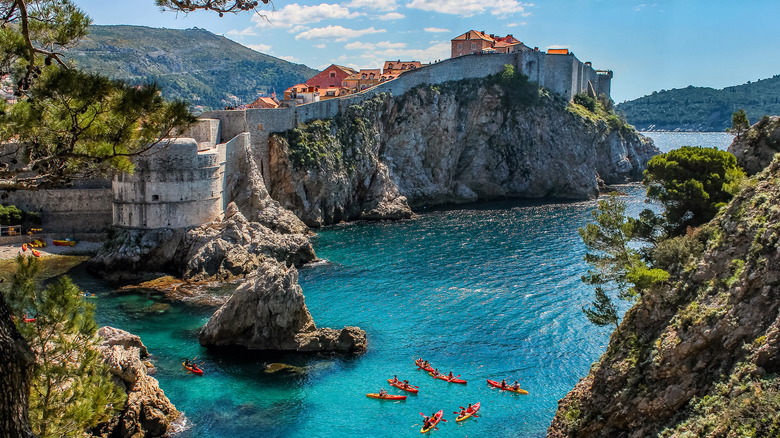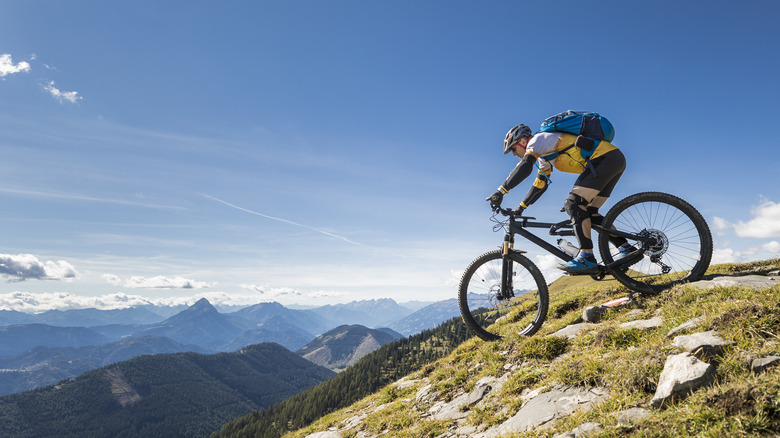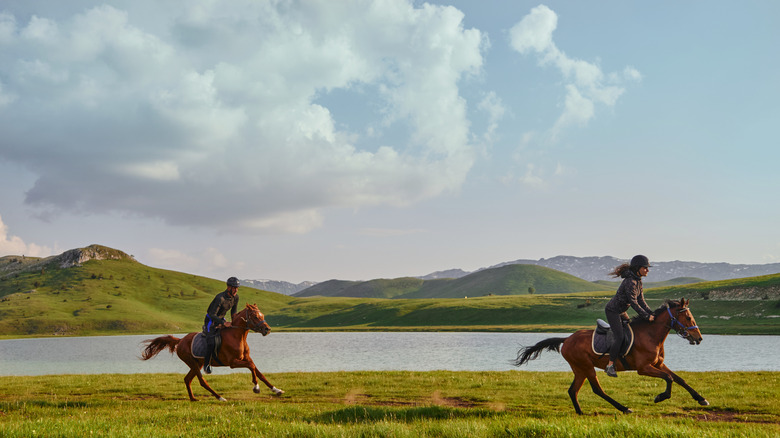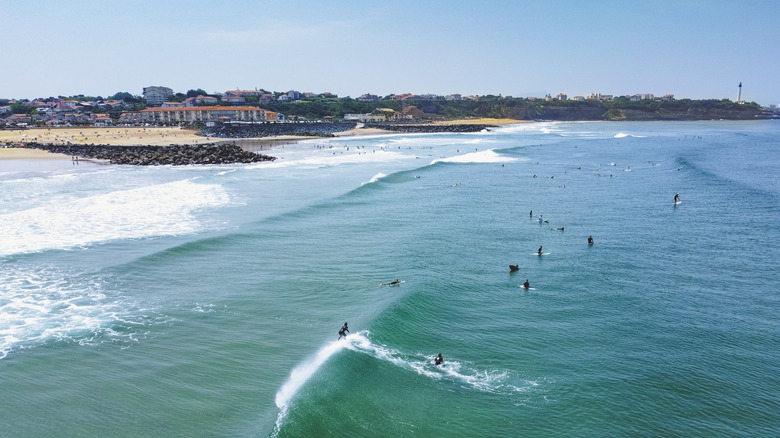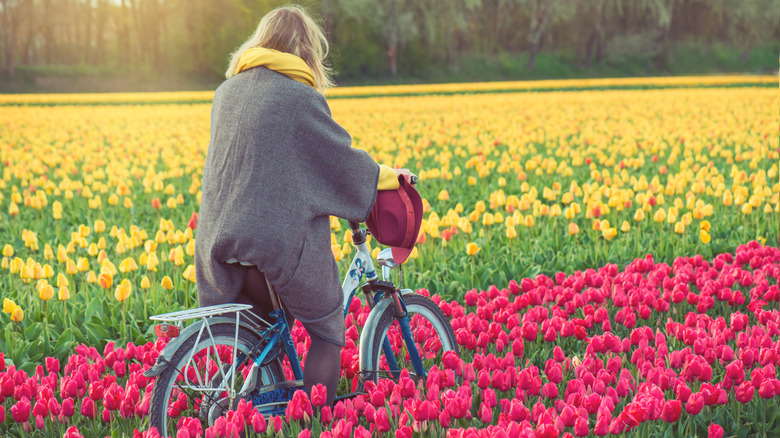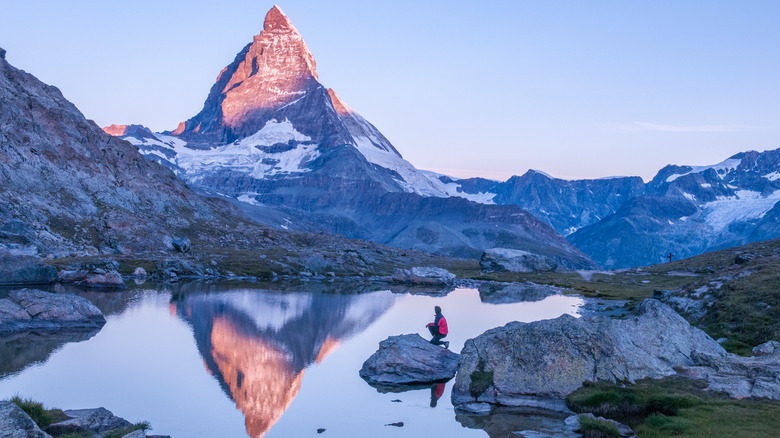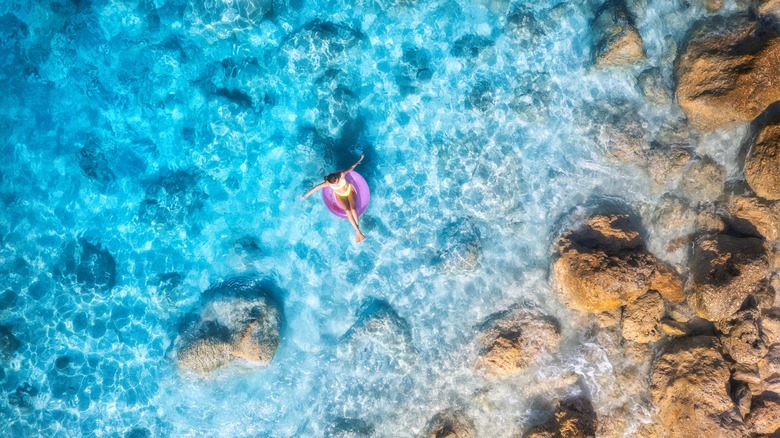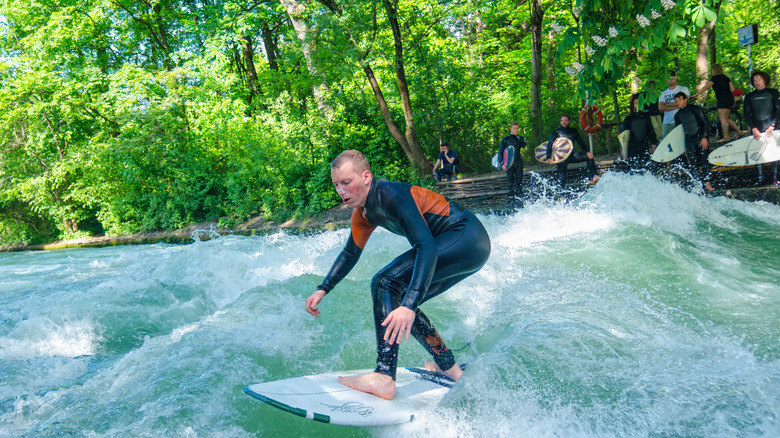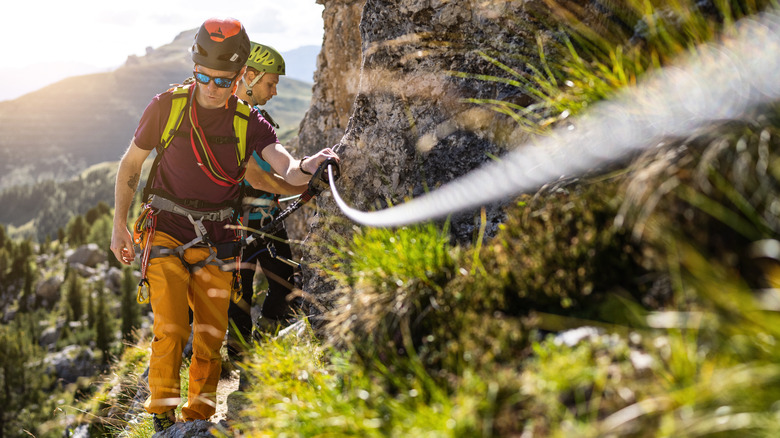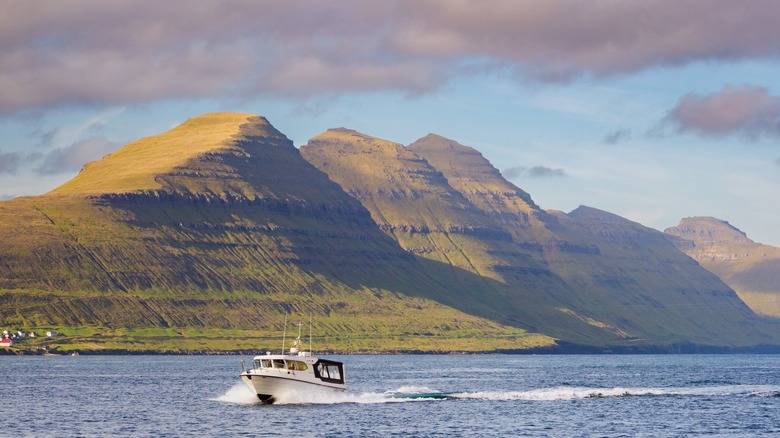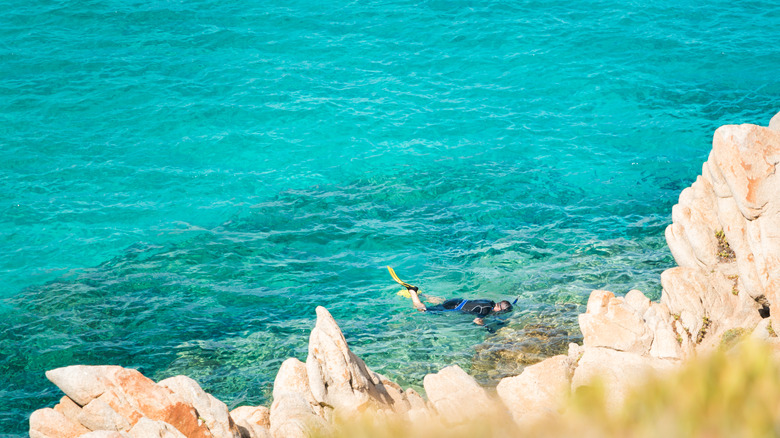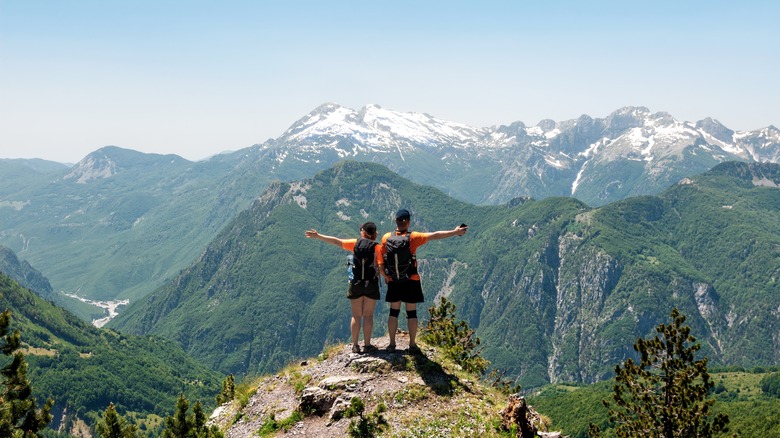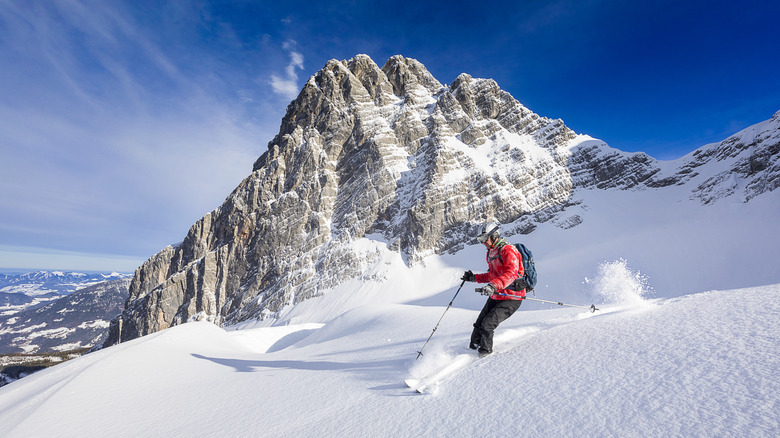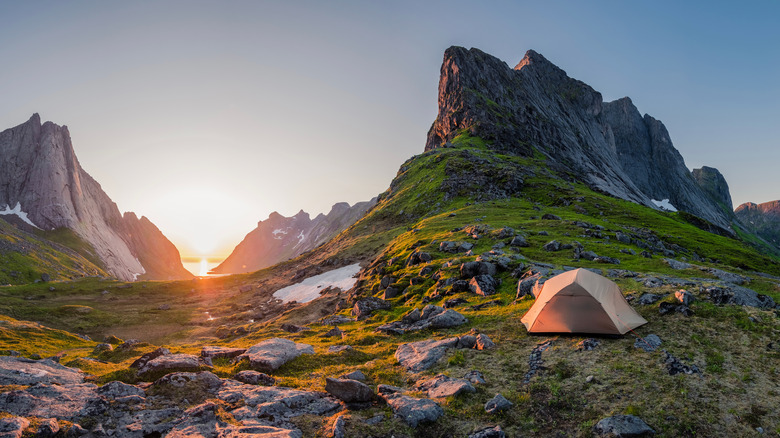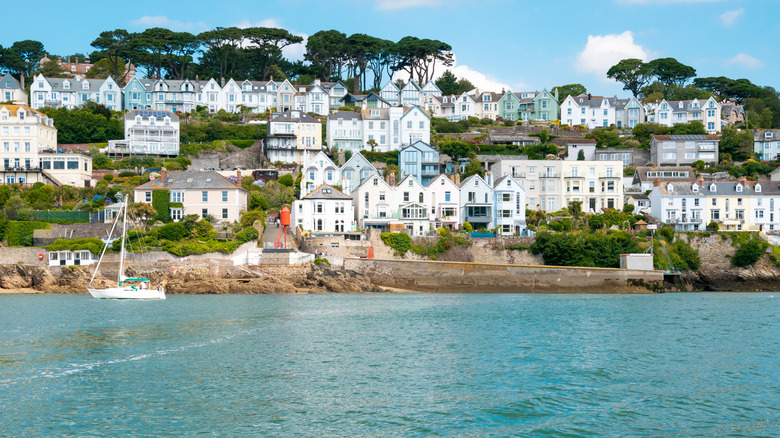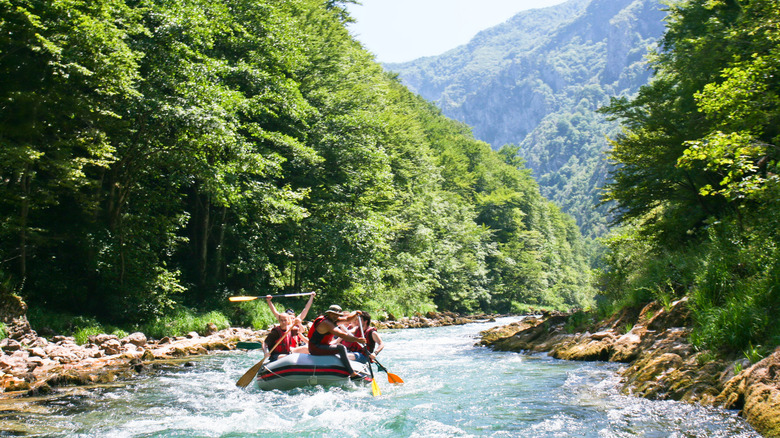The Best Outdoor Activities To Try On Your Next Trip To Europe
A trip to Europe is a big undertaking to plan and, understandably, it can be tempting to focus mainly on the big cities. But perhaps it would be fun to consider trying some new outdoor activities on your next trip. Sure, we all want to see the canals of Amsterdam, the lights of Paris, and the amazing historical monuments, but museums, statues, and trivia facts can quickly begin to blur together.
What better way to break up informative walking tours, art descriptions, and tasting menus than time in nature? Here are 17 of the best outdoor options to try out on your next European vacation — you might just fall in love with it and find your new outdoor hobby!
Sea kayak in Dubrovnik, Croatia
Dubrovnik is famously overcrowded, thanks to a hit HBO show from a few years back. And while "Game of Thrones" is long-gone off-air (unless you count spin-offs and reboots), the impact it had on the Dalmatia coast has lasted. During the peak summer season, you'll be hard-pressed to find a restaurant or bar with enough seating or enough room to move more than a few inches. This is particularly true on the City Wall walk, arguably the most popular experience in Dubrovnik. And while the views from above are absolutely stunning, there's a fantastic alternative for a unique look at the city.
If you're not water-shy, getting out on the ocean on one of the many kayak tours is a fantastic alternative to sightseeing. Many companies offer group and private rentals with different sightseeing options, depending on what you wish to view. You can opt to paddle out to Lokrum Island, circle the City Walls, visit caves and beaches only accessible via the water, or a combination of all of the above! Tours are typically available from mid-April through October and while you'll be given a wetsuit, still come prepared to get wet.
Mountain bike in Tyrol, Austria
The Austrian Alps are known as a great place to hike in the summer and a premier ski destination from the holiday season all the way through the spring. However, the mountains in this part of Europe are also fantastic for a lesser-publicized activity — mountain biking. Taking two wheels instead of two feet on the trails means you'll cover more ground in less time and be able to take in even more views along the way. And thanks to the great winter ski infrastructure, there are plenty of cable cars and chair lifts in place to carry you and your bike to your ideal starting place.
Innsbruck, East Tyrol (particularly Hohe Tauern National Park), the Reschen Pass, and Lake Achensee are considered the best hubs in the region for mountain bikers. Tyrol is also known as one of the more "free" biking locations where you can choose more or less where to begin and end your ride, as opposed to other places where routes and directions are predetermined. The season typically begins in May and lasts through October, depending on how fast the snow melts and how early the first flurries begin to fall. It will also be dependent on the elevation of your chosen trail.
Ride horses through Montenegro's mountains
This up-and-coming Balkan destination is already famous among mountain lovers, but if Croatia has long been a non-hidden gem, Montenegro isn't far behind. So go now! But don't just limit yourself to popping into Kotor (which, like its Croatian neighbor, Dubrovnik, also has a cruise ship problem). Instead, take a trip into nature. This beautifully verdant country is worth a few days at least, but ideally a few weeks. And while hiking is synonymous with the mountains that make up the majority of the area, one of the best ways to cover ground and enjoy landscapes is to go horseback riding.
Numerous companies and ranches offer day rides and multi-day treks. See the best of the country from the animated colors of the tree-filled peaks to the clear blue waters of its lakes and rivers, all from atop a trusty steed. Not only will you have a better place to see it all, but you'll also have a unique experience and cover quite a lot in a much shorter amount of time.
Surf the Atlantic in Biarritz, France
Spain and Portugal might be the most popular for those looking to catch a wave on their European vacation, but the Atlantic coast of France is a wonderfully lesser-visited destination. Biarritz in particular is an up-and-coming location for surfing and is known for consistent waves, a rarity in even the best surf spots around the world. The year-round temperate climate means the beach is a comfortable destination during most months, you just might need a few more layers during winter months. And while the water isn't tropical by any means, a wetsuit will keep you cozy even in January.
This town in southwestern France is known to be a fantastic place to surf for beginners, for a few reasons. First, if you know when to visit, the waves are not only consistent but also tamer than other first-rate surf destinations, which tend to favor the more experienced. In Biarritz, spring through October is best for calmer waters and beginner surfers, particularly in the summer. There are also a fair number of surf schools in the area, so no worries if you don't have previous experience. If you are seasoned on the waves, you can pretty much catch them year-round here.
Bike across the Netherlands
Amsterdam and the Netherlands are famously bike-friendly and thus, there isn't a better place to go for your next cycling vacation. No matter what time of year you visit, the landscapes will offer plenty to enjoy. From tulips in spring to windmills year-round and endless beaches for the warmer months, there's always something to see here. Plus, the flatness of the country ensures you'll be able to ride for miles and miles without exhausting yourself too much, even with snacks and gear on board. Instead of just hitting up Amsterdam and moving on to the next country like every other tourist, you'll be enjoying the country as the locals do — on two wheels,
A bike is also the cheapest way to get around the Netherlands, where public transportation is well-connected and usually on time, but expensive. Additionally, you'll have the freedom to choose any route and visit all the charming Dutch towns that have been on your list. Cycle paths crisscross here like highways, so you'll be hard-pressed to find a destination you can't reach with a bike. Just don't forget your rain attire, plenty of cyclists and a decent amount of rain are both expected throughout the seasons here.
Go fox hunting in Ireland
Smartly dressed riders, turned-out horses, and a pack of hounds, all making their way through the rolling hills of the Emerald Isle. No, it's not the beginning of a period piece (although it could very well be describing that) but rather, it's a fox hunt. Long a national pastime, there's no friendlier place to join a hunt than in Ireland, whether it'syour first or your fiftieth time visiting.
Trot down old bog roads with views of the ocean, take a gallop around sheep-filled pastures, and canter by ruins that are thousands of years old. There are plenty of outfits that will plan your Irish fox hunting holiday, but you can also just Google the local hunt in the area you plan to visit. Most are quite happy to have new riders join, even for just a day, and can usually assist in finding you a horse. You'll likely make a few new friends along the way, just be careful, as you might not want to leave at the end! Note that the season for this hobby is typically from October/November through February.
Take an overnight backpacking trip through Switzerland
The Swiss Alps are the stuff of legend among hikers and backpackers and there is no better place to do either activity. There are numerous regions and towns to choose from as a base for your adventure, and all offer a variety of trails and climbs for all levels of hikers. The Appenzell region is a fairytale-like area full of rolling green hills and storybook-like homes in the German-speaking part of the country. Bernese Oberland is best known in the Jungfrau region, but the peaks in these parts are stunning no matter where you choose to backpack.
The Valais is located in the southwest, in the French-speaking canton where you'll find the Haute Route, arguably the most famous in Switzerland, from Chamonix to Zermatt. Engadine borders Italy and Austria and is less popular than some of the other areas. Jura is lesser-known to non-Swiss backpackers and the quaint towns surrounded by mountains full of options for routes are a great spot to start off your journey. The area of Ticino is also full of picturesque paths along lakes where it's easy to hike from one B&B to the next. No matter where you choose to adventure, the huts along all trails are well-stocked, the trails well-sign-posted, and the public transport between locations is amazing. Just remember this isn't a cheap country to visit, but, if you pay the tourist tax in most villages you'll receive a visitor card for the area, which can mean free or discounted public transportation.
Swim (or relax) on a Greek island
White-washed buildings and electric blue water, there's a reason Greece has long been a top holiday destination. The Mediterranean is synonymous with beaches and relaxation, and the Greek islands are truly the best places to swim during a European summer trip. However, there are a few things to keep in mind before you set off on a trip. The warmer months are the best months to spend on the shores, but that's also the busiest and most expensive time to visit. If you have a flexible schedule, it's recommended to plan a trip during June, September, or October to avoid crowds and enjoy better rates. The water will still be warm enough to swim and the weather still hot enough to make you want to jump in.
Just be aware that many islands outside of the most famous like Santorini, Mykonos, and Corfu are seasonal. Because of this, shoulder and off-season may mean that many restaurants, tour providers, and even accommodations will be closed. However, if you're looking for a chilled-out vacation, it's perfect. Also, bear in mind the islands are sectioned off into separate chains with specific ferry routes. It is extremely uncommon to find ferries between islands in different chains. If you want to island-hop, you may need to return to Athens and change boats to swap routes.
Surf the river in Munich, Germany
Munich often conjures up visions of beer halls, quintessential Bavarian architecture, and, of course, plenty of green spaces. If you're planning an outdoor trip from the city, chances are you've decided to hike or ski in the nearby Alps. But, if you're more of a water-sports person, don't fret, Munich has plenty to offer.
One of the more unique activities you can try while visiting Germany is surfing on the Eisbach River. Right in the heart of the city in the Lehe district, you can watch surfers catching waves at all hours of the day. People have been doing so for decades and while you can find spots along rivers in other cities, the Eisbach is known as the best and most consistent. If you want to try surfing here, you should be experienced as the waves can be unpredictable, the water shallow and cold, and the current strong.
Climb or mountaineer the Italian Dolomites
Austria, France, and Switzerland might be the destinations most often thought of for mountain getaways, but Italy's Dolomites are a great place to do so as well. This is particularly true if you want to try your hand at rock climbing or mountaineering, as plenty of schools here offer lessons and excursions.
Depending on the location you choose, courses can be completed throughout the year, but be sure to pack snow gear if you visit during winter. During these months, you'll join skiers on the lifts into the peaks to practice mountaineering skills. In the spring you can combine ski touring between huts with a climbing course and in summer, you'll have all of the mountains at your disposal thanks to the melted snow.
Fish in the Faroe Islands
The secret has been out for a while about the Faroe Islands, but you can still have a unique trip if you're open to exploring the open sea. The islands are known for sweeping ocean views and top-rate seafood. So, if you're willing to catch your own, you can enjoy a typical Faroese excursion — fishing in the Atlantic. You'll have the option of deep-sea or fly fishing and the species you'll hook is quite the variety. From cod to halibut to catfish, squid, flounder, pollock, and everything in between, you'll never be bored on the water out here. Plenty of operators offer tours where you can enjoy waiting for a bite with some of the best scenery in Europe.
If you bring your own equipment, remember to disinfect everything prior to arrival to prevent transferring any disease to Faroes waters. You'll also need to purchase a license before dropping a line (if you book a tour, the company will assist or handle this for you.) The fishing season is typically from late July through October, but remember to double-check before planning a trip.
Snorkel in Sardinia
Southern Europe's beaches and water are popular among many water-activity enthusiasts, but snorkeling doesn't always come to mind as it does with say, Australia or the Caribbean. However, Sardinia's crystal clear waters make it the perfect place to spot sea life and underwater attractions.
The beach called Cala Domestica on the southwestern part of the island has underwater caves and abundant schools of fish. The Cala Spinosa area also has great beaches nearby and is sheltered by cliffs for a pleasant snorkeling experience. Maddalena Island is off the north of Sardinia and is full of seabed teaming with life, and it's also a less-frequented area to snorkel.
Hike through Albania's mountains
Western Europe might get all the fame when it comes to the Alps and Albania might be an up-and-coming location for the beach, but the Alps here have some of the best hiking in the Balkan region and European continent. There are two main mountainous regions in the country, the city of Shkoder in the north of the country (not far from the border with Montenegro) is the entry point for the Albanian Alps. However, note that tourism is still new to the area and it's recommended to use a guide as signposts, huts, and other amenities can be few to nonexistent. Shkoder is just under a two-hour bus ride from Tirana.
Alternatively, you can head south to Gjirokaster, one of the oldest cities in the country, dating back to the Ottoman era. Most homes still retain that look. The Gjerë mountains surround the town and make for a great base to hit the trails. Gjirokaster is also just an hour from the beaches of Sarande and the Albanian Riviera, should you want to relax after your hiking trip.
Ski the Alps
France, Germany, Austria, Switzerland, Italy ... It doesn't really matter where you choose to go because where there's snow, there's also some of the best skiing in the world! But before you hit the slopes, you'll need to consider a few factors. The mountains and powder in this part of the world are all top-notch and each country will have numerous options for all levels. First is the language. Because Brits and Americans have been flying into all of the above to ski for decades, resort and lift staff typically speak English. However, if you want to explore further afield than the mountain, it's usually helpful to know a bit of the local language and of course, it's always polite to learn a few words.
Additionally, you'll want to check flights well ahead of time for this vacation. If flights to Geneva and Zurich are double those to Munich or Vienna, you'll need to take that into consideration. And finally, the food. Most alpine villages will have plenty of fondue and raclette cheese on offer, but it's most often found in France and Switzerland. And of course, beer will be the drink of choice in Austria and Germany, wine in France, and a mix in Switzerland. All of them have wonderful chocolate and desserts. The alpine ski season typically begins in December and lasts through April.
Wild camp and hike in Norway
The Norwegian word and concept "friluftsliv" roughly translates to "love of the outdoors" and the stunning scenery of the country could likely convert even the most nature-adverse person to subscribe to this lifestyle. One of the more unique aspects of Norway is that it is legal to camp and hike on any public land. The "right to roam" is uniquely Norwegian and encourages everyone to get out and explore the beautiful countryside.
So as long as you take all equipment, food leftovers, and garbage with you and minimize the impact on the area, you're allowed to hike and camp on non-private land. If you set up camp, you must do so at least 500 feet away from the nearest building structure. Additionally, it is prohibited to go to the bathroom anywhere but toilets (you'll see signs for many along the trails.) So if you want to save a bit of money on this famously-expensive destination, bring a tent and set up camp literally anywhere! Norway is a Nordic country, so keep in mind that the best months are the summer — when the days are long and warm.
Set sail in the U.K.
Most people head to Greece or Croatia for sailing trips, but if you want to learn or don't have much experience, the coast of the U.K. is the perfect place to visit. The south of England is considered the premier destination for boat trips, particularly Cornwall, Brighton, and Portsmouth. The picturesque seaside towns are favorites thanks to the clear waters, sandy (or pebbled) shores, and quaint town centers.
There are also many outfits that will teach you to sail or hold a refresher course if it's been a few years. Rent a boat for an hour or two or all day and enjoy one of the best outdoor activities you can try in Europe.
Go rafting in Bosnia & Herzegovina
Bosnia & Herzegovina is mostly known as a day trip from Croatia or thought of for the war that happened in the '90s, but there's so much more than that. The Neretva River, located just an hour or two from either Sarajevo or Mostar is ripe with opportunities for water sports. A favorite activity is rafting, particularly near Konjic where you can find some of the best waters among a picturesque canyon.
You'll need to book a tour to do so, as rafting is notoriously dangerous and the logistics can be tricky, especially abroad. The water isn't very warm, so this is only possible in the summer months, usually April through October.
